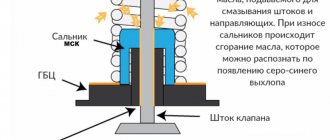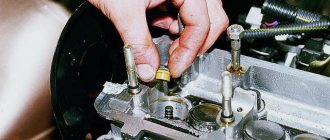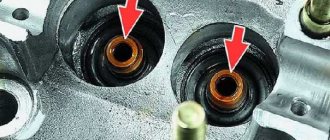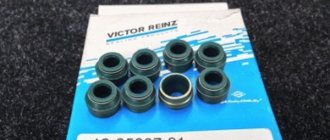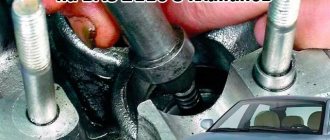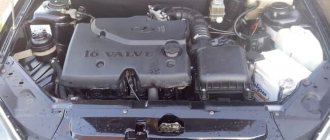Timing valve seals, better known as “oil seals,” prevent oil from entering the combustion chamber from the cylinder head when the valves are opened. The service life of these parts is approximately 100 thousand km , but with aggressive use, the use of low-quality fuels and lubricants and after a long period of engine inactivity (more than a year), the oil seals wear out faster. As a result of wear of the oil seals , oil enters the combustion chamber , causing the engine to lose power and operate unstably, and oil consumption increases significantly.
We will tell you in this article how to determine the wear of valve seals and how to eliminate it.
Why is oil intensively consumed?
In a working engine, valve stem seals and rings are responsible for removing residual lubricant from the valve stem and cylinder walls, respectively.
At high speeds, the performance of this process decreases, but in general, oil consumption does not exceed the norm prescribed by the manufacturer. For some it is 1 l/10,000 km, for others it is 0.3 l/10,000 km, and still others may not add anything at all between service intervals, since they do not turn the engine above 3,500 rpm. Naturally, when lubricant consumption suddenly increases, say, to 1 l/1,000 km, and even blue smoke comes out of the exhaust, this is a signal of a violation of the oil scraper functions. There are several reasons for this:
- The oil scraper rings are stuck.
- The caps have become stiff.
- The valve guides are worn out.
As a result, it would be nice to determine without disassembly which particular group of parts failed. Whether this is possible is the topic of the next paragraph.
What are these parts?
Oil rings are related to piston rings and play a big role in the performance of a car. This part consists of an upper compression ring, a compression oil scraper ring and a lower oil scraper ring. The following parameters depend on their operation: the amount of acceleration power, how toxic the exhaust gases are, engine starting and the amount of fuel and oil consumption. Therefore, it is so important to monitor their technical condition.
Valve seals or rings: how to determine what caused the blue smoke
If you've done a quick study of the issue, you've probably noticed that there is a lot of conflicting information. For example, there is a lot of controversy around the same compression: some argue that with normal pressure in the cylinders there is no reason to go into the piston, others insist that this is not an indicator at all in the current situation. And regarding the relationship between the engine temperature, the position of the gas pedal and the time of appearance of bluish smoke, it is not at all clear what’s what.
Let us immediately note that there is no connection between compression and defective oil scraper rings. Firstly, the rings that scrape oil from the cylinders wear out or become stuck first, while the compression rings continue to work as expected. Secondly, even with slightly worn compression rings and damaged oil scraper rings, compression will be normal, since the oil remains on the cylinder walls.
At the same time, unspoken differences exist that make it possible to determine what exactly has failed: caps or oil scraper rings. The difference is that each group of parts produces blue smoke at different intervals.
Symptoms of problems with caps
In the old days, stiff or worn valve seals were indicated by a puff of bluish smoke that burst out of the exhaust pipe immediately after starting the engine. By the way, these observations have not lost their relevance today. Even in this situation, it would be a good idea to ask how much the work costs and what else needs to be changed when replacing the valve stem seals on the engine.
The following test will help you accurately judge the caps for replacement:
- Warm up the engine to operating temperature.
- Let the engine run for 5-7 minutes while warm.
- Sharply depress the gas pedal for 5-10 seconds and watch the exhaust gases at this moment.
If there are problems with the seals, in the first seconds of the “gas to the floor” mode, a cloud of smoke with a bright bluish tint flies out of the muffler. For extra confidence, repeat the attempt to throttle to failure 2-3 more times. Observations are such that in subsequent cycles the puff of smoke will lose saturation, and may even disappear altogether.
For your information. The most reliable diagnosis is considered to be based on the color of the exhaust, in which “gas to the floor” is given after warming up and running the engine at operating temperature for 5-7 minutes. The bluish tint under such conditions turns out to be much more saturated than during the morning start and other gas conditions.
What explains this prioritization? If the cap is worn, oil will flow down the valve stem when the engine is running. Whether it will accumulate on the valve plate or immediately enter the cylinders is determined by the angle of the throttle valve. So, at idle, the speed of the air mass is low, the oil is not removed from the plate, but continues to accumulate. As soon as you sharply (it is important to press this way) press the gas pedal, air or the fuel-air mixture (depending on the type of fuel injection) draws the accumulated oil emulsion into the cylinders and it burns, forming a bluish smoke.
There will be no ominous tint at revs, and, in fact, there shouldn’t be. The oil does not have time to accumulate, but immediately enters the cylinders and burns in small fractions, which is why it does not affect the color of the exhaust gases.
It is worth noting that with a new catalyst, the color of the exhaust may not change at all, since it qualitatively converts CH into water vapor. On a half-dead catalytic converter or installed flame arrester, the picture appears in all its glory: there is smoke.
How to determine whether oil rings are faulty
Worn rings make themselves felt when under load. In reality, it looks like this: the color of the exhaust gases changes when moving uphill with the gas pedal half-pressed. It is worth noting that looking in the rearview mirror, you are unlikely to draw the right conclusion. The puff of smoke usually dissipates quickly. However, the driver of the car behind may well record his appearance.
For your information. There is an opinion that the initial stage of wear should be determined during gear shifting. If bluish smoke appears at this moment, the rings will need to be replaced soon.
When the rings are worn critically, smoke comes out constantly while driving and regardless of the terrain under the wheels. In addition, an increase in smoke is observed with increasing speed.
What else could cause a bluish-colored exhaust?
A defective turbine and faulty crankcase ventilation can also cause smoke. What distinguishes these failures from current caps or oil rings is the nature of the smoke: there is a lot of smoke + it can appear and disappear at any time. For example, the engine runs smoothly at idle and suddenly starts smoking, and after 3-4 minutes it stops.
A few tips will help you figure out what's going on:
- The turbine “drives” oil into the exhaust pipe. Smoke appears only after the exhaust tract has warmed up. There may be an oil leak at the joints of the exhaust system parts.
- Crankcase ventilation does not separate the oil from the air mixture. The oil separator is clogged as a result of using low-quality engine lubricant. The intake manifold is covered in streaks of oil emulsion, and clearly behind the ventilation hole.
If the seals are worn
Stubborn and worn caps appear in clouds of bluish smoke that erupts from the exhaust pipe immediately after starting the engine.
In addition, you can diagnose oil seals as follows:
If smoke of a rich bluish color appears, then we can confidently assume that the seals have failed.
In this case, the oil will flow down the valve stem and enter the cylinder when the throttle valve is sharply opened while pressing the gas pedal. At this moment, blue smoke from the burnt grease will burst out of the pipe.
At stable speeds there will not be much exhaust, since under such circumstances the engine oil will not have time to accumulate on top. The lubricant enters the cylinder in minimal doses, so during combustion there will be no change in the color of the exhaust gases. If the car is equipped with a new catalyst, the exhaust gases are purified more efficiently. Therefore, under such circumstances, it is generally impossible to notice any smoke.
Thus, the methods described above make it possible to fairly accurately determine the cause of the appearance of bluish smoke, which suddenly begins to escape from the exhaust pipe.
Source
Parting recommendations
If diagnostic results are unsatisfactory, experienced owners usually act by elimination. First, an attempt is made to decarbonize the oil scraper rings. If this is your first time encountering this concept, we recommend reading about what decarbonization is and why the engine needs it, as well as about the technology for decaburning piston rings using dimexide, as one of the inexpensive and effective means.
If an attempt to remove coke does not bring results, then work is planned on the cylinder head. If replacing the valve stem seals is unsuccessful, then a “overhaul” is performed.
Hi all!
Let me start with the fact that
in a Honda Element with a K24A4 engine there are 16 of them
, namely:
Part number: 12210-PZ1-004 HONDA (item “1” in the diagram), INTAKE oil scraper cap, 8 pieces;
Part number: 12211-PZ1-004 HONDA (item “2” in the diagram), Oil scraper cap OUTLET, 8 pieces.
Spare parts are cheap and
fit the Element from almost any other Honda.
Photos of the original cap packaging (real):
may also find it useful on this topic
know the PCV valve number.
Part number: 17130-PND-A01 HONDA (item “1” in diagram 2), PCV valve (Valve Assy., PCV).
We’ve sorted this out, now it’s worth talking about how it “looks” or, in other words, we need to decide on the cause and color of the exhaust!
And the smoke, the smoke is different! “Black”
- fuel (very high consumption);
Compression ring operation
The compression ring bears the most load, so special alloyed materials are used in its manufacture. Its surface is coated with a wear-resistant substance so that the ring can withstand gas pressure and high temperature. As the ring approaches top dead center, there is less lubrication, and increasing pressure in the cylinder ensures that the ring adheres more tightly to the cylinder. At the same time, the speed of movement decreases, and when stopping completely, the oil film may rupture. In this case, the compression ring experiences dry friction during operation, which means rapid wear.
Cause of smoke in the exhaust pipe
In order to understand the question of why the engine smokes, you need to have an idea of what happens in it during operation.
A fuel mixture is formed in the combustion chamber, which is compressed by the piston and ignited by a spark from the spark plug. The mixture is supplied through the inlet valves, and the spent mixture is discharged through the outlet valves. The pistons have special oil intake rings; they are needed to collect excess oil on the cylinder walls so that it does not enter the combustion chamber.
The engine valves also have special seals (caps), which serve to ensure that the oil located in the cylinder head does not enter the combustion chamber. In addition, spark plugs also play an important role, and if they have a weak spark, or the gaps between the electrodes are incorrectly set, then the fuel mixture in the engine will not burn completely.
Based on this, we can identify the following causes of engine smoke.
- Spark plug . If the spark plugs are faulty, that is, they produce a weak spark, or the gaps between their electrodes are set incorrectly, then the fuel mixture does not burn completely and is discharged from the combustion chamber with blue smoke. In the most severe cases it may be black.
- Piston oil intake rings. As stated above, oil intake rings perform a function related to cleaning the cylinder walls of excess oil so that it does not enter the combustion chamber. They are subject to a powerful frictional force. If they wear out, the oil enters the combustion chamber and ignites along with the fuel mixture. In this case, black smoke appears. Similar functions are also performed by engine rings, which also remove excess oil from the surface of the cylinders and can wear out over time.
- Valve caps. These are seals that serve to prevent the oil in the cylinder head from entering the combustion chamber, and are made of dense rubber. When it wears out, the lubricant enters the combustion chamber and ignites. This produces white (or bluish) smoke.
The last two reasons for smokiness will be discussed below. If a car owner notices the appearance of blue or blue smoke, he needs to pay close attention to the operation of the power unit’s spark plugs and have them diagnosed or replaced.
You need to remember that sometimes the cause of smoke in the exhaust pipe can be bad gasoline. It may contain various additives or additives that will create black or other colored smoke. This problem usually disappears when refueling with other fuel.
Partial cleaning
What is the essence of this method? To work, we need a cleaning fluid, which should be used to drive about two hundred kilometers. In this case, you cannot significantly load the engine. This is due to changes in oil viscosity. It becomes more liquid after adding the washing mixture.
Where can I buy this liquid? Today it is not difficult to find such products in automobile stores. It is enough to clarify the engine parameters, and then use flushing according to the instructions. It is added through the oil filler neck.
Diagnosis of faulty engine oil rings
As stated above, if the engine smokes black, then the problem is that the piston oil rings are worn out and lubricants are leaking into the combustion chamber.
Ignoring this problem can lead to the fact that the rings will not remove the lubricant, and therefore it will need to be constantly refilled. In addition, the rings may become stuck and will need to be decoked. You can learn how to decarbonize stuck rings from other publications. But it is better to do this at a specialized service station.
Now let's move on to consider the question of how to diagnose this problem.
There are two ways, the first is a compression test, which will be discussed in detail below.
The second is diagnostics with the power unit running.
In order to determine the problem with the rings, it is imperative to warm up the engine to operating temperature, since this problem only appears when the power unit is running hot.
Then press the gas pedal, giving standard or increased speed. If black smoke comes from the exhaust pipe, then the problem is in the rings and they need to be replaced.
How to replace the piston rings in this case. Here you will have to disassemble the cylinder head, remove the pistons, buy a new set of rings and replace them. If the car is foreign-made, then it is better to entrust such work to specialists, since doing this without removing the engine will be problematic.
It is important to remember that if the problem is in the rings, then the engine will generally have difficulty starting after a long period of inactivity.
Instrumental check
A few words need to be said about how the technical condition of the engine is checked using instruments. To do this, you need to have a device called a compression meter. It doesn’t make sense to purchase it just for checking the engine, but we can say with great confidence that someone in the garage cooperative will have it. We can also say with great confidence that checking with its help gives the correct answer about the condition of the motor.
The compression test should only be carried out with the engine warmed up to operating temperature. You need to remove the spark plugs from the cylinder head, put the car on the handbrake and the gear shift lever in neutral. Next, forcefully insert the head of the compression gauge into the spark plug socket. After this, independently or with the help of an assistant, crank the engine crankshaft for a few seconds with the starter. The device will show the compression in this cylinder.
If its value is low, it is recommended to check again, but before doing so, pour 20-30 grams of engine oil into the cylinder. An increase in the compression value after this will confirm the wear of the piston rings. Coking of the piston rings can also help reduce compression. You can fight this, but this is a topic for another article.
To avoid this problem for as long as possible, follow all operating recommendations given by the manufacturer. Why the engine smokes, how to understand whether it’s the caps or rings after reading this article should become clear. Therefore, you need to try to ensure that the engine runs for a long time with clean exhaust.
Diagnosis of faulty valve caps
If the engine smokes white, then the problem is in the caps. White smoke can also have a bluish tint. Based on this, the car owner urgently needs to change the seals on the valves, otherwise he will experience high engine oil consumption.
This problem can be detected when the engine is running cold, or while driving.
Let's consider the first case. The car enthusiast should park the car in a garage or other place and wait until the engine cools down. After this, put it in neutral gear and start the engine, giving speed.
When starting in this way, white or bluish smoke will pour out of the exhaust pipe. This means that oil enters the combustion chamber through the valve caps.
The second method requires the driver to be observant. When the car is moving, you need to accelerate it, then brake the engine, and press the gas pedal again, giving significant speed. In this case, you need to constantly look in the rearview mirror. If white or bluish smoke starts pouring out, then you can safely diagnose a faulty cap.
What to do in this case. This problem can be solved in your garage. You just need to remove the old seals and replace them with new ones. This type of work does not require great skills and even a beginner can handle it.
It is important to remember that if the car still smokes with replaced oil seals, then the problem may be in other engine components, so in this case it is better to contact specialists and carry out professional diagnostics.
note
For flushing, you need to use liquids specially designed for this purpose. It is not recommended to use acetone, kerosene and other liquids. This method was used by Soviet drivers when the rings were stuck in the VAZ-2106 engine. What can acetone do to the motor in this case? After washing, the oil is completely washed out of the cylinders. When starting, the engine runs dry for some time, which can lead to the formation of scoring. Specialized flushing fluids do not cause such harm, so they can be used without fear.
Replacing parts
Decarbonization can only help with carbon deposits, but if the parts are worn out, then they only need to be replaced. Replacing rings and valve stem seals can be done with your own hands. It is done using a special puller, a mandrel for pressing, a metal rod, you will also need tweezers and a desiccant. When purchasing new caps and rings, it is best to give preference to original parts, because counterfeits will not last long. Moreover, the coating material of the upper rings should ideally match the material of the engine.
First you need to remove all components and mechanisms to get to the parts. The first thing to do is remove the air filter, then the fuel pump and the ignition distributor. To dismantle the drive housing of the auxiliary elements, disconnect the bolted connection. Then comes the removal of the negative terminal and the toothed pulley. To release the cylinder head cover, remove the mass drive. Now unscrew the nuts of the front and rear camshaft bearing housings.
Remove the camshaft key and take out the oil seal. We set the piston to TDC, remove the spark plug, insert a rod into the hole so that the valve does not fall out, after that you need to compress the springs and remove the two crackers, press out the rings.
Installing new parts in place occurs exactly in the reverse order. Oil scraper rings for VAZ models are changed in the same sequence.
